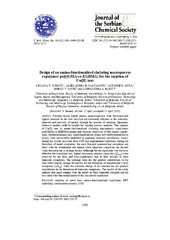Design of an amino-functionalized chelating macroporous copolymer poly(GMA-co-EGDMA) for the sorption of Cu(II) ions
Дизајн аминофункционализованих хелатних макропорозних кополимера поли(гма-ко-егдма) за сорпцију Cu(ii) јона
| dc.creator | Suručić, Ljiljana T. | |
| dc.creator | Nastasović, Aleksandra | |
| dc.creator | Onjia, Antonije E. | |
| dc.creator | Janjić, Goran | |
| dc.creator | Rakić, Aleksandra A. | |
| dc.date.accessioned | 2020-04-13T10:21:24Z | |
| dc.date.available | 2020-04-13T10:21:24Z | |
| dc.date.issued | 2019 | |
| dc.identifier.issn | 0352-5139 | |
| dc.identifier.uri | https://cer.ihtm.bg.ac.rs/handle/123456789/3473 | |
| dc.description.abstract | Polymer-based, highly porous nanocomposites with functionalized ligands attached to the core structure are extremely efficient in the detection, removal and recovery of metals through the process of sorption. Quantum-chemical models could be helpful for sorption process analyses. The sorption of Cu(II) ions by amino-functionalized chelating macroporous copolymers poly(GMA-co-EGDMA)-amine and sorption selectivity of the subject copolymers, ethylenediamine (en), diethylenetriamine (dien) and triethylenetetramine (trien), were successfully modelled by quantum chemical calculations. Considering the crystal structures from CSD and experimental conditions during the formation of metal complexes, the most frequent mononuclear complexes are those with the tetradentate teta ligand, while binuclear complexes are formed when the metal ion is in large excess. Although the en-copolymer was the most effective functionalized one, higher maximum sorption capacities (Qmax) were observed for the dien- and trien-copolymers, due to their abilities to form binuclear complexes. The enthalpy term has the greatest contribution to the total Gibbs energy change of reaction for the formation of mononuclear Cu(II) complexes (ΔGaq), while the solvation energy of the reaction has the greatest contribution in the formation of binuclear complexes. The results of the study indicate that small amines with the ability to form binuclear complex are the best choice for functionalization of the considered copolymer. | en |
| dc.description.abstract | Квантнохемијско моделовање се показало као корисна алатка за разјашњавање процеса сорпције, као и за предвиђање структуре насталих производа те сорпције. Уз помоћ квантнохемијских прорачуна успешно су моделаовани процеси сорпције Cu(II) јона и селективност тих сорпција на амино-функционализованим хелатним кополимерима поли(глицидил-метакрилат-ко-етиленгликол-диметакрилат) (поли(GMA-ко- -ЕGDMA)) са различитим бројем амино група у свом саставу (етилен (-en), диетилентриамин (-dien) и триетилентетраамин (-trien) кополимери). Узимајући у обзир кристалне структуре из CSD и експерименталне услове приликом формирања комплекса са Cu(II) јоном, дошли смо до закључака да су најчешће структуре мононуклеарних комплекса са тетрадентатно везаним лигандима, али да се бинуклеарни комплекси јављају када је јон металa у вишку у односу на кополимер. Без обзира на то што је кополимер са en-лигандима најефикасније функционализован, најбоља сорпција Cu(II) јона (Qmax) се, ипак одиграва на dien- и trien-кополимерима. Овакав резултат је последица боље способности dien и trien лиганада за грађење бинуклеарних комплекса са Cu(II) јонима. Највећи допринос укупној промени Гибсове енергије реакције грађења мононуклеарног Cu(II) комплекса (ΔGaq) потиче од енталпијског члана. Међутим, пресудну улогу на формирање бинуклеарних комплекса има солватациона енергија. Резултати наше студије показују да су краћи амини са могућношћу формирања бинуклеарних комплекса најбољи избор приликом функционализације разматраних кополимера за потребе сорпције Cu(II) јона. | |
| dc.language.iso | en | sr |
| dc.publisher | Belgrade : Serbian Chemical Society | sr |
| dc.relation | info:eu-repo/grantAgreement/MESTD/Basic Research (BR or ON)/172043/RS// | sr |
| dc.relation | info:eu-repo/grantAgreement/MESTD/Basic Research (BR or ON)/172023/RS// | sr |
| dc.relation | info:eu-repo/grantAgreement/MESTD/Integrated and Interdisciplinary Research (IIR or III)/43009/RS// | sr |
| dc.rights | openAccess | sr |
| dc.rights.uri | https://creativecommons.org/licenses/by-nc-nd/4.0/ | |
| dc.source | Journal of the Serbian Chemical Society | sr |
| dc.subject | Sorption of metal ions | sr |
| dc.subject | Amino-functionalized copolymer | sr |
| dc.subject | DFT modelling | sr |
| dc.subject | Coordination isomers | sr |
| dc.subject | CSD | sr |
| dc.title | Design of an amino-functionalized chelating macroporous copolymer poly(GMA-co-EGDMA) for the sorption of Cu(II) ions | en |
| dc.title | Дизајн аминофункционализованих хелатних макропорозних кополимера поли(гма-ко-егдма) за сорпцију Cu(ii) јона | |
| dc.type | article | sr |
| dc.rights.license | BY-NC-ND | sr |
| dcterms.abstract | Суручић, Љиљана Т.; Ракић, Aлександра A.; Јањић, Горан В.; Оњиа, Aнтоније Е.; Настасовић, Aлександра Б.; | |
| dc.citation.volume | 84 | |
| dc.citation.issue | 12 | |
| dc.citation.spage | 1391 | |
| dc.citation.epage | 1404 | |
| dc.citation.rank | M23~ | |
| dc.identifier.doi | 10.2298/JSC190125031S | |
| dc.identifier.fulltext | https://cer.ihtm.bg.ac.rs/bitstream/id/16295/bitstream_16295.pdf | |
| dc.identifier.scopus | 2-s2.0-85079543416 | |
| dc.identifier.wos | 000506674800005 | |
| dc.type.version | publishedVersion | sr |


